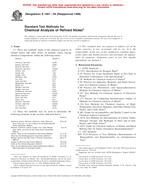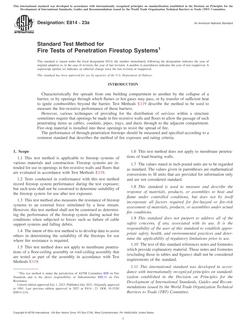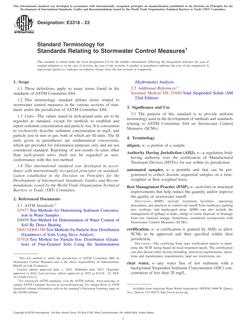ASTM E1587-94(1998) 82 PDF Download

1.1 These test methods apply to the chemical analysis of refined nickel and other forms of metallic nickel having chemical compositions within the following limits:
Element Weight % Antimony, less than 0.005 Arsenic, less than 0.005 Bismuth, less than 0.01 Cadmium, less than 0.0025 Carbon, max 0.03 Cobalt, max 1.00 Copper, max 1.00 Hydrogen, max 0.003 Iron, max 0.15 Lead, less than 0.01 Manganese, less than 0.20 Nickel, min 98.0 Nitrogen, less than 0.50 Oxygen, less than 0.03 Phosphorus, less than 0.005 Selenium, less than 0.0010 Silicon, less than 0.005 Silver, less than 0.01 Sulfur, max 0.01 Tellurium, less than 0.0010 Thallium, less than 0.0010 Tin, less than 0.005 Zinc, less than 0.015
1.2 These test methods may be used to determine the following elements in the sections indicated below:
Sections Antimony, Arsenic, Bismuth, Cadmium, Lead, Selenium, 20 to 30 Silver, Tellurium, Tin, and Thallium by the Electrothermal Atomic Absorption Method Bismuth, Cadmium, Cobalt, Copper, Iron, Lead, Manganese, Silver, and Zinc by the Flame Atomic 8 to 19 Absorption Method Carbon, Total, by the Combustion-Instrumental Method 8 31 to 42 Nickel by the Dimethylglyoxime Gravimetric Method 12 91 to 99 Nitrogen by the Inert Gas Fusion Thermal Conductivity Method 8 66 to 77 Oxygen by the Inert Gas Fusion Method 8 78 to 90 Sulfur by the Infrared Absorption Method 8 43 to 54 Sulfur by the Methylene Blue Spectrophotometric Method After Generation of Hydrogen Sulfide 55 to 65
1.3 This standard does not purport to address all of the safety concerns, if any, associated with its use. It is the responsibility of the user of this standard to establish appropriate safety and health practices and determine the applicability of regulatory limitations prior to use. For specific precautions, see Section 5.
Product Details
- Published:
- 12/10/1998
- Number of Pages:
- 28
- File Size:
- 1 file , 300 KB


